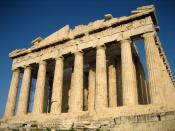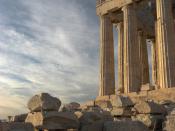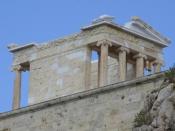In roughly the center of ancient Athens stood a 500 foot Dolomite outcropping known as the Athenian Acropolis (Greek meaning high city). During the 5th century B.C. an extensive building program, initiated by the statesman Pericles, created several public building on the rocks crowning the plateau. These structures, in the order they were constructed were: the temple of Athena Parthenos (the Parthenon), 447-432 BC; the Propylaea (gateway), 437-432 BC; the temple of Athena Nike, 427-424 BC; and the temple of Erechtheus (the Erechtheum), 421-405 BC.
Although commissioned by Pericles the structure is the work of primarily three men; Ictinus and Callicrates, the designers and architects and Phidias who was responsible for the sculptures. The building, following the Doric Order, is made entirely of white pentelic marble and surrounded by free-standing columns. The structure survived Greco-Roman times as a temple and then in later ages has served in succession as a Byzantine church, a Roman Catholic Church, a Turkish harem, and a Turkish powder magazine.
The majority of the damage done to the Parthenon occurred on September 16, 1687, when during a war between the Turks and Venice, a direct hit by Venetian artillery caused the Turkish powder being stored in the Parthenon to explode, scattering debris across the Acropolis. This explosion scattered the sculptings of Phidias on the ground where the British governor Lord Elgin (1802-03) collected them and sent them to Britain as naval supplies. Today, they are on display in the British Museum.
The stone for the construction was cut from Mount Pentellicus which stands some ten miles from the city proper. It was rough dressed on the cutting site and then transported to the city by teams of oxen. There it was transferred to wagons pulled by mules for the long haul up to the acropolis. This...



Entertaining and amusing
This paper kept my attention and informed me of a lot of information. Great essay!!
7 out of 7 people found this comment useful.